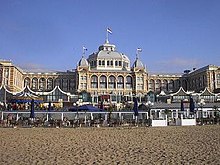Kurhaus Scheveningen
Coordinates: 52 ° 6 ′ 47.8 " N , 4 ° 16 ′ 54.5" E
The Kurhaus Scheveningen is a listed building in the seaside resort Scheveningen , a district of The Hague in the Netherlands . The building served as the central spa from 1885 to 1969 and was operated as the Steigenberger Hotel from 1979 to 2014 . It has been part of the Amrâth Hotel Group since October 2014.
history
The history of the Kurhaus Scheveningen goes back to shipowner Jacob Pronk (1762–1838). Pronk started building a bathhouse on Scheveningen beach in 1818. Bathers were given the opportunity to bathe in tubs that were filled with sea water. Above all, rheumatic diseases should experience relief in this way. Pronk's concept was a success. In 1820 he had the wooden bath house replaced by a stone building.
The fact that Pronk had discovered a lucrative source of income did not go unnoticed by the government in The Hague. In order to replenish the public coffers, it was decided to take over the business. In 1828 the seaside resort passed into the hands of the city of The Hague. The design of the building was based on the Kurhaus in Aachen .
In 1854 the town bath house was extended by two side wings and demolished 30 years later.
architecture
The Kurhaus, which opened on July 11, 1885, was built from 1884 by the German architects and contractors Johann Friedrich Henkenhaf (1848–1908), his brother Jakob Henkenhaf (1850–1927) and Friedrich Ebert (1850–1914).
The building has the shape of an open three-wing complex , which is based on the floor plan of a baroque castle and is aligned parallel to the coastline. On the lake side, the wings include a terrace. The middle wing is crowned by a dome that quickly became the symbol of the seaside resort. The outer facade is made of yellow-red facing and light house stone , and is thus optically based on the brick facade customary in the country . The main social room in the building is the Kursaal , in which musical and festive events took place in a representative setting.
History of use of the Kurhaus
On September 1, 1886, the building burned down. The fire is said to have originated when an alcohol stove fell over while a nanny was cooking porridge. The Kurhaus was rebuilt and reopened on June 19, 1887 after only nine months of construction. The construction costs amounted to 600,000 guilders . The ceiling paintings of the Kursaal ( Dutch : Kurzaal ) were made by the Belgian painter's workshop Van Hoek. A large number of famous personalities stayed in the Kurhaus in the period that followed. The Golden Guest Book includes composers and artists such as Brahms and van Gogh , crowned heads such as Empress Elisabeth (Sissi), the Austro-Hungarian Emperor Franz Joseph I and the German Emperor Wilhelm II, and politicians such as Roosevelt , Churchill and Brandt .
In the 20th century, the bathing culture in Scheveningen was subject to drastic changes. Royal guests stayed away, a middle-class audience came. The management of the Kurhaus, which from 1903 was in the hands of the “Exploitatie Maatschappij Scheveningen” (EMS), wanted to take this into account. High quality entertainment such as concerts, dinner dances and cabaret shows were in demand .
In 1918 the Scheveningen spa celebrated its 100th anniversary. The first pier , which led from the center of the Kurhaus into the sea, was built in 1901 and destroyed in the Second World War. The second pier opened in 1961. As one of the largest piers in Europe, it consists of four islands that contain restaurants, numerous shops, a casino and a 45 m high observation tower.
On August 8, 1964, the Rolling Stones gave a concert in the Kurhaus, which went down in a great commotion and had to be broken off. On the walls next to the bar in the Kursaal there are photos and information boards with the names of world-famous artists who performed in the Kurhaus.
Towards the end of the 1960s, the management of the Kurhaus operated with significant losses, so that the decision had to be made to close the Kurhaus. EMS sold the Kurhaus in 1973 to a consortium that wanted to demolish the Kurhaus. It was thanks to the sharp protest by the government in The Hague that the demolition plans could be prevented. The most important reason for saving the Kurhaus was the guest register, which had become the subject of public interest. The golden book became an object for the study of graphologists and historians, who recognized in the register a treasure trove of information unique of its kind.
The Kurhaus was closed in 1969. In the years between 1972 and 1975 it was completely renovated and in 1975 it was given the status of a listed building ( Rijksmonument ) in the Netherlands. The reopening of the Kurhaus was made in 1979 by Princess Beatrix . The hotel was managed by Steigenberger Hotels AG from 1979 to 2014 . It has been part of the Amrâth Hotel Group since October 2014.
Web links
- Kurhaus Hotel Scheveningen In: holland.com (German)
- Grand Hotel Amrâth Kurhaus In: denhaag.com (German)

